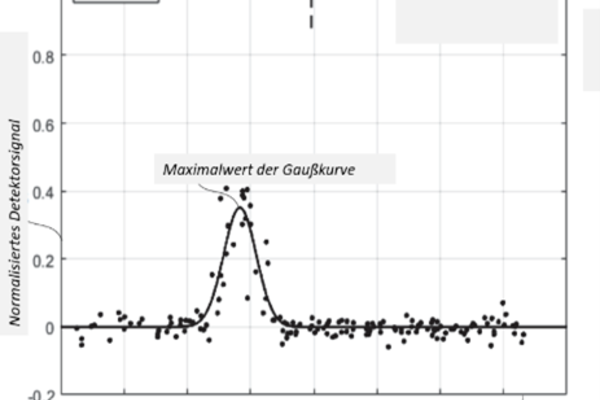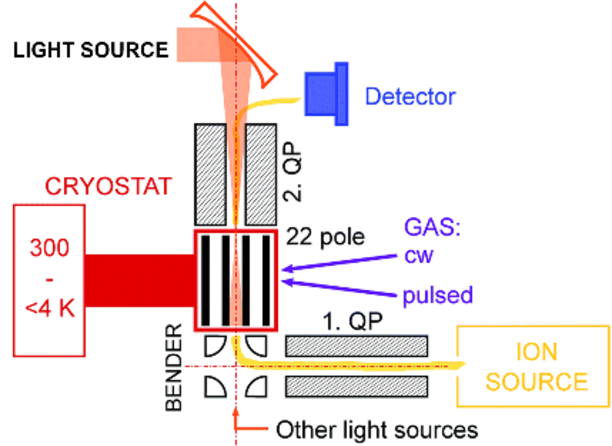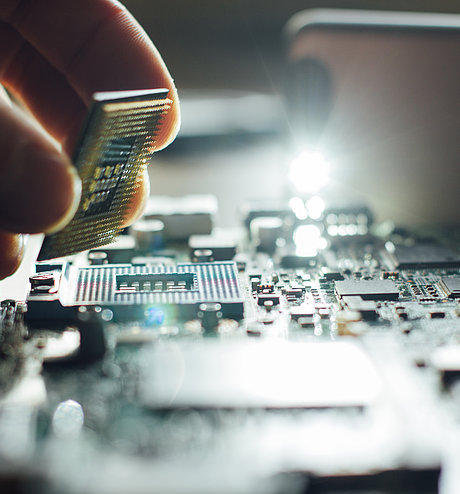Selective ion storage - Procedure for measuring molecular spectra in ion storage, removing molecules or isomers in a targeted manner, and determining sample composition
Ref.-No. 6190
Keywords: Ion trap, spectroscopy in ion traps, action spectroscopy, molecular energy transfer, buffer gas cooling, optical spectroscopy. Isomers, confomers, enantiomer
The new method generates spectra of charged molecules in ion storage. To accomplish this, specific excited ions are removed from storage. This can proceed to complete removal of a molecule or isomer (a molecule with the same mass but different structure). This method thus allows quantitative determination of a sample’s composition, even if the components cannot be separated with mass spectrometry alone. What is new with respect to the state of the art is that ions experience a specific inner excitation that can be converted to kinetic energy by means of shocks with a neutral gas, causing some of the excited ions to leave storage. An ion’s spectrum is then determined from the number of ions released as a function of the excitation frequency. This new method is therefore called “leak-out spectroscopy”. The figure shows the rotational oscillation transition line for the HCO+ molecule generated by the method outlined.
Competitive Advantages
- Selective ion traps
- Targeted molecule removal
- Sensitive measurement procedure
- High sensitivity
- Combination of mass and optical spectroscopy
Commercial Opportunities
The invention’s technology allows spectra of various types of ions to be measured. It also allows, for the first time, separating isomers that differ only in their excitation frequencies. It also differentiates between right-handed and left-handed molecules, which other methods do not. The new procedure can be used to determine any type of ion species spectrum (rotation, oscillation, ro-vibration, electronic, etc.). The composition of electron and nucleus spin states can also be determined. This produces completely new applications in such areas as pharmaceuticals.
Current Status
The invention was reported to the German Patent and Trade Mark Office on 10/22/2021, and further subsequent foreign applications can be submitted in the priority year. The invention’s functionality has been demonstrated in initial laboratory tests. Initial publications of both molecule spectroscopy and quantitative determination of isomer compositions are being prepared. On behalf of the University of Cologne, we are offering companies the opportunity to license this technology and cooperate within the inventor in its refinement.
Technology Readiness Level
1
2
3
4
5
6
7
8
9
Experimental proof of concept
Relevant Puclications
Brett A. McGuire, Oskar Asvany, Sandra Brünken & Stephan Schlemmer, Laboratory spectroscopy techniques to enable observations of interstellar ion chemistry, Nat Rev Phys 2, 402–410 (2020). doi.org/10.1038/s42254-020-0198-0
Sven Fanghänel, Oskar Asvany, Stephan Schlemmer, Optimization of RF multipole ion trap geometries, Journal of Molecular Spectroscopy Volume 332, February 2017, Pages 124-133
Other publications about this invention are being prepared. Their release is planned in 2022.
—
An invention from the University of Cologne.




